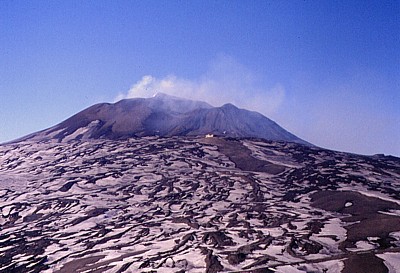| Etna
index |
||
| Geology | Geological history | Cones and craters |
| Eruptive characteristics | Eruptions before 1971 | Eruptions since 1971 |
| Etna and Man | References | Web sites |
| Weather forecasts | FAQ | Latest news |
| View
from the Montagnola toward the summit craters of Etna on 12 February
1998. The Southeast Crater, which has changed beyond recognition
since then, lies to the right of the then much larger central summit
cone, and a small intracrater cone looms over its rim. This cone,
which began to form about one year earlier, was the site of a fairly
regular Strombolian activity, and lava issued from vents at its
base, overflowing the crater rim in many places. The building in
front of the Southeast Crater is the Torre del Filosofo mountain
hut, an amazingly ugly structure (in terms of architecture), which,
however, has provided shelter and served for hosting scientific
monitoring instruments. In spite of its exposed location and its
proximity to the eruptive sites of 2001 and 2002-2003, it is still
there... though completely buried by the pyroclastic products of
the latest eruption |
Etna
photo gallery: 2000
Etna in full force
![]()
If
we believed to had seen it all, after the incredibly intense and
varied summit activity of 1998-1999, Etna was ready to give us yet
more surprises. And while it may be a matter of discussion whether
the new millennium started with the year 2000 or only with 2001,
the volcano was in the mood to celebrate anyway. On 26 January 2000,
the Southeast Crater reawakened with a powerful paroxysm that at
first sight seemed to be a precise repetition of the 4 February
1999 paroxysm. But rather than continuing with quiet outflow of
lava for many months, as in the previous year, the activity soon
ended and was followed by a second paroxysm three days later, and
another one three days thereafter. Starting on 1 February, similar
paroxysms occurred at ever shorter intervals - initially one per
day, then two per day, and between 10 and 17 February, some days
even had three of these events. Although the rate of paroxysms decreased
after 19 February, these events eventually constituted the most
frantic series of lava fountains ever seen on any volcano on Earth.
By late June, the Southeast Crater had produced 64 (sixty-four)
paroxysms, and two further occurred in late August. During the same
period, another peculiar phenomenon was seen at the Bocca Nuova:
a small vent within this crater emitted rings of vapor. Not just
a few, but thousands. Sometimes, when there was little
wind, one would see up to ten of these vapor rings drift simultaneously
in the sky above the summit of the volcano. Before the year 2000,
there had been little doubt that among the volcanoes of this planet,
Etna was one of the most extraordinary, but in 2000 it went absolutely
beyond. However, the year ended with a marked decline in the activity; the last important event was a period of somewhat stronger Strombolian activity at the Bocca Nuova, which seemed at first to lead to another spectacular eruption like that of October-November 1999. But things took an entirely different course in the following year. |
|
As for the previous years, the photographs taken of Etna in 2000 are presented on separate pages: Exploring a rapidly changing world, early February 2000 Lava fountain on Valentine's Day, 14 February 2000 Fiery embrace for Torre del Filosofo, March 2000 A tourist show turns into inferno, April 2000 A feeling of "Dante's Peak", May 2000 Feeling the hot breath of the Southeast Crater, June 2000 Etna takes and gives a break, July-August 2000 The Bocca Nuova returns on the stage, September-October 2000 |
Copyright © Boris Behncke, "Italy's Volcanoes: The Cradle of Volcanology"
Page set up on 7 February 2004

